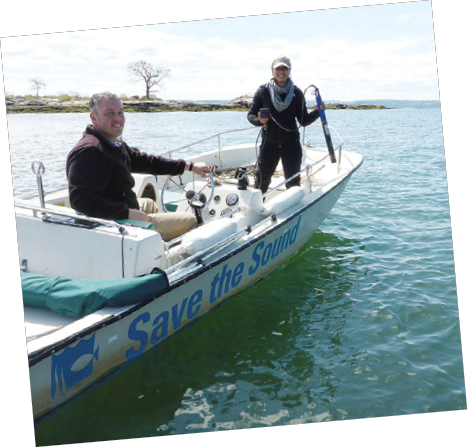By Peter Linderoth, Water Quality Program Manager for Save the Sound
 Scientists are taking a new look at the way they collect data in local harbors. Under the leadership of Save the Sound, the new Unified Water Study brings together citizen groups to consistently measure the ecological health of bays and harbors around Long Island Sound. Together, we expect to monitor 36 bays and harbors in New York and Connecticut this summer. These groups run the gamut from local environmental groups to municipal and federal organizations. There’s a camaraderie among the participants that contributes to the success of the sampling season.
Scientists are taking a new look at the way they collect data in local harbors. Under the leadership of Save the Sound, the new Unified Water Study brings together citizen groups to consistently measure the ecological health of bays and harbors around Long Island Sound. Together, we expect to monitor 36 bays and harbors in New York and Connecticut this summer. These groups run the gamut from local environmental groups to municipal and federal organizations. There’s a camaraderie among the participants that contributes to the success of the sampling season.
The author and Save the Sound Environmental Analyst Elena Colón testing water quality in Mamaroneck Harbor. Water testing demonstrations by “Sound Sleuths” in Long Island Sound are ongoing. TV crews and reporters are welcome to film dockside or on board the test boats. Contact Burns Patterson at 917-575-9155 to schedule. © Save the Sound
Why a Unified Water Study?
The Unified Water Study (UWS) is designed to assess the environmental health of our Long Island Sound bays and harbors. Abundant data are already being collected in the “main stem” of Long Island Sound by federal and state agencies, although there are data gaps in over 100 bays and harbors. Along the coastline of our Sound, these areas are frequently used for recreation and enjoyment. This study is designed for community sampling groups to fill in these gaps with high quality data. That information will be used to inform managers making decisions to protect and restore our estuary while also providing the public with an idea of how the water and its inhabitants, are faring in their local bay, harbor, or inlet.
All groups follow a set of identical field procedures in the data collection process, which allows for comparable results across waterways. Following these set procedures also helps ensure the data being collected for this effort are high-quality.
First and foremost, the study is designed to assess the impacts of excess nutrients in our Sound’s bays and harbors. Excessively high levels of nutrients, especially nitrogen, have been damaging the Sound ecology for decades. It can lead to harmful algal blooms, salt marsh loss, and fish kills. The study’s baseline water quality parameters, which Save the Sound began tracking in 2016, are dissolved oxygen, temperature, salinity, water clarity, macrophyte surveys (aka seaweed and eelgrass), and chlorophyll a. These parameters help identify high nutrient inputs to a waterway and document their harmful impacts.
The study also has the added benefit of uniting community sampling groups around the Sound into a growing network. This collaboration brings about benefits that are beyond the high quality data collected every season. The collective voice and efforts of the UWS monitoring groups will bring about sustained coordinated water quality sampling, more local data, and a far-reaching set of eyes on the water.
The network of professionals involved goes beyond just the water quality monitoring teams. A diverse array of state, federal, municipal, and non-governmental representatives met to design this study and provide feedback to ensure we have our bases covered in terms of longevity and data usability.
Save the Sound piloted an additional level of the study this past summer, which integrates continuous dissolved oxygen logging, nutrients, and video surveys of the Sound floor for deeper analyses.
For 2018, we are adding another ten groups to the study, bringing the total to 21. Monitoring results will be shared with New York State, Connecticut, and the Environmental Protection Agency. They will also be made public and integrated into the Long Island Sound Report Card in future years. That is a whole other story, so stay tuned!
This article was originally posted at Green Cities Blue Waters, a blog by Connecticut Fund for the Environment and its bi-state program Save the Sound, and is reprinted with permission. For more information, visit greencitiesbluewaters.wordpress.com and ctenvironment.org.




